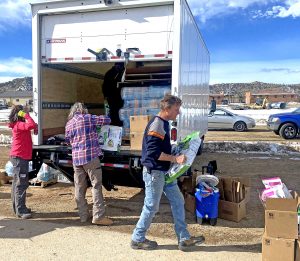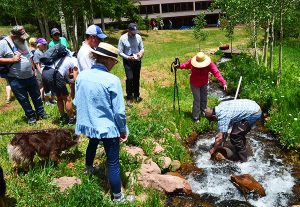by Carolyn Newman
WALSENBURG — This series of articles on the 1913-14 coal miners strike focuses on Huerfano County events and on the Ludlow tent colony. Today’s article covers weeks three and four of the strike. The complete southern Colorado strike story, dubbed by many as the “Great Coalfield War,” may be found in many excellent books in libraries.
A 16-year-old boy newly arrived from Italy was so frightened he couldn’t talk.
Twenty striking miners spotted the teenager, Joseph Garraco, at the Walsenburg railroad station Oct. 15 and thought he was a strike breaker. So they marched him off to strike headquarters on Sixth Street.
Finally a fellow Italian got him talking and the boy explained he was on his way to meet his step-brother, or brother, the stories vary, at Delagua mine. The union men went to work to find Garraco’s step-brother for him.
Meanwhile firing continued every night in the hills around Walsenburg and on Seventh Street. Of the thousands of shots fired over the course of the 15-month-long strike, it is remarkable more persons were not hit.
Walsenburg women again took an active part in the strike when a crowd of females from Seventh Street attacked a non-union miner at the Walsen mine. He sometimes met his wife and small daughter at an irrigation ditch near the mine. This night the Seventh Street group waited and, when the trio was talking, attacked. Camp guards rescued the family, and, for safety, the wife and daughter moved into the camp.
Those Seventh Street women had another plan. A wife of a working miner from the Cameron mine, about one and a half miles south from the west end of Seventh Street, walked into town to shop. On her way home, she was grabbed, shoved, hair pulled and generally abused. She promised she would have her husband quit work. When he heard his wife’s story, the miner armed himself and started for town. When a guard stopped him, the Mexican miner emptied his revolver at him – his five shots missed. The miner turned himself in anyway.
No one was safe, even at the movies. On Sunday, a bunch of strikers took two non-union men from the Klein’s picture show and forced them to the union headquarters to sign up with the union.
These all were considered minor incidents. “The general situation in Walsenburg is good,” reported the Pueblo Chieftain. But everyone knew tensions were mounting, especially in Las Animas county. Some 18 men employed by the United Mine Workers in the West Virginia strike were on their way to southern Colorado for reinforcements.
In fact, trouble started Oct. 15 at 11 a.m. when picketing miners at the Walsenburg Rio Grande railroad depot reported 12 strike breakers had arrived and were to be sent to the Walsen mine. Strikers rushed to the depot and intercepted Juan Garicino, the man in charge of the strike breakers (scabs). Garicino ran to the courthouse for the sheriff’s protection. The strikers followed and surrounded the courthouse, but eventually they left, only to keep watch around town for Garicino. He stayed in the jail.
Meanwhile, “protected by 150 shots,” a gang of men blew up the Rio Grande railroad trestle that led to the Oakview mine. After the dynamite failed to destroy the bridge, they tried to set it on fire using coal oil. The mine guards used fire extinguishers and put it out.
Leaders of the union strikers and the leaders of the mine operators apparently tried to keep things calm. The mine operators asked the strikers at the Ludlow tent colony to move the tents several miles away from the mine so people passing by would not be in danger. The union asked that the searchlight, about two and half miles from the tents, be removed. No action was taken by either side.
Gov. Elias Ammons was reluctant to send in the National Guard to keep peace, partly because financing would be a huge problem for the state. Colorado was still paying off the two earlier military campaigns.
This photo shows the Rouse mine’s ventilator fan housing. The strikers were concerned about mine safety and circulating fresh air into the mine was critical to safety. Remains of concrete buildings housing ventilator fans are visible today along County Road 342 (the Mutual road) south and west of Walsenburg. Photo courtesy of Huerfano County Historical Society, the Virginia Allee collection.
Information is from the Oct. 16 and 17, 1913 issues of the Pueblo Chieftain and Oct. 11, 1913, Trinidad Chronicle-News.

Breaking news: Results of Walsenburg Mayor race and recall election
Gary M. Vezzani was elected Walsenburg’s mayor in Tuesday’s special mayoral election/recall vote. Preliminary results announced Tuesday night show that both Nick Vigil in Ward



